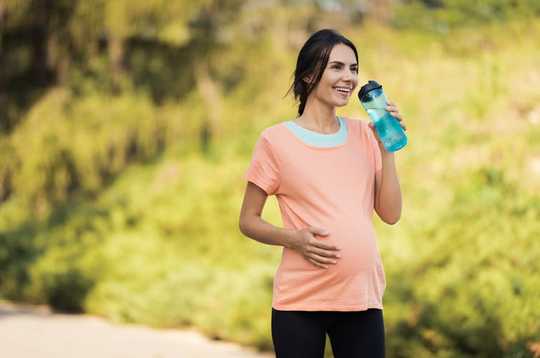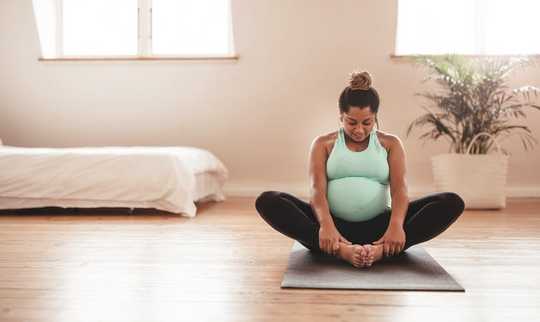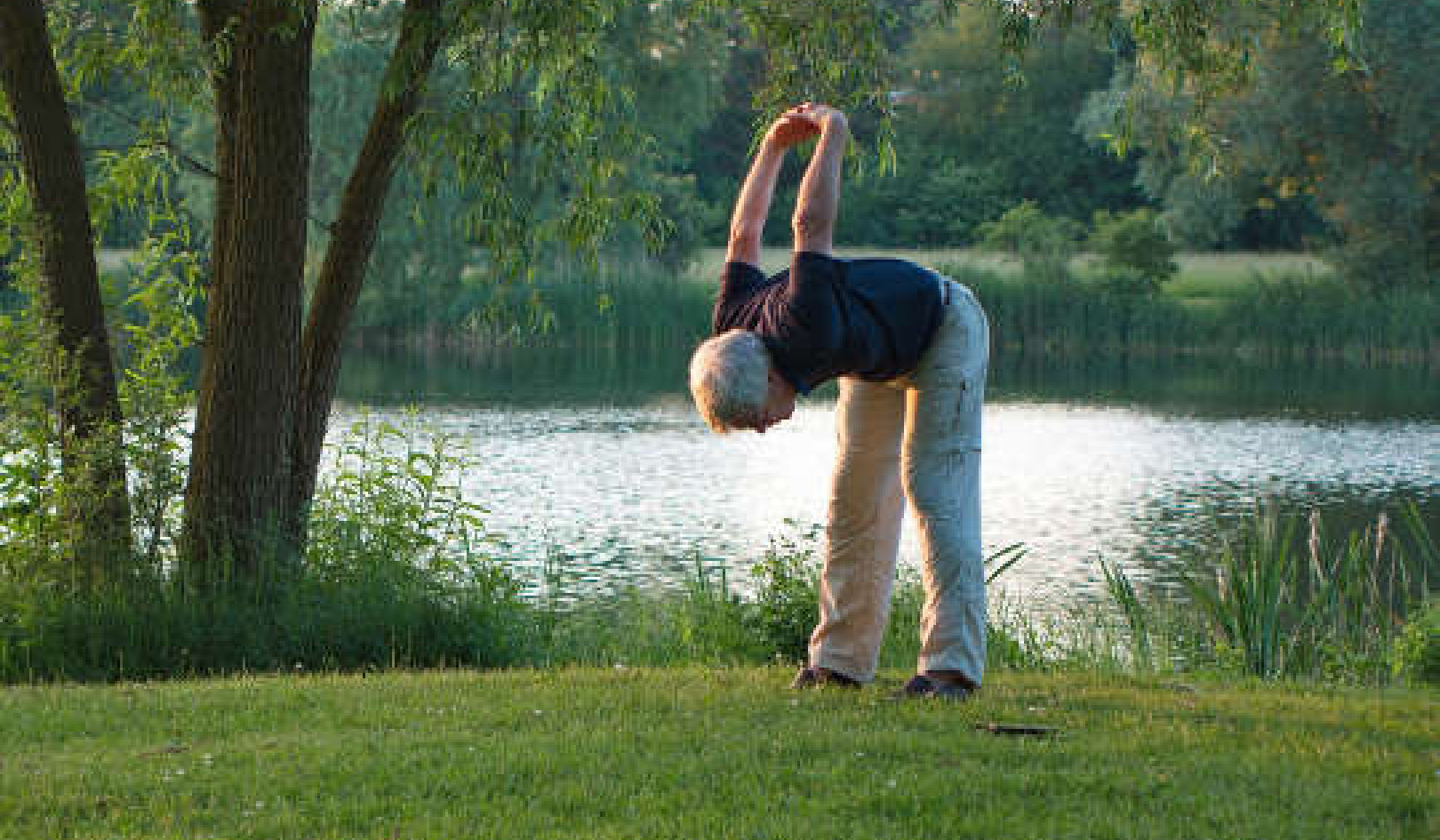
Vigorous exercise is safe while pregnant, even in the final trimester. But if you don’t feel up to it, lighter exercise is beneficial too. From shutterstock.com
Expectant mothers receive an avalanche of information about potential risks to their baby. There’s a growing list of foods, toxins and environmental threats to avoid. It’s normal for this to lead to an increased level of anxiety.
As a result, some women believe it’s safer to avoid any risks in pregnancy, no matter how small. Vigorous exercise may be considered one of these risks.
But we’ve recently reviewed the research and found vigorous exercise is safe during pregnancy, including in the third trimester. And not only is it safe; it’s healthy, too.
Moderate exercise vs vigorous exercise
The safety of moderate intensity exercise during pregnancy has been well established. Walking, swimming and using an exercise bike are all activities that could be considered moderate intensity.
Expectant mothers who do at least 150 minutes of moderate intensity physical activity per week, as recommended by the Australian Physical Activity Guidelines, are healthier, happier, stronger, and develop fewer complications like gestational diabetes and pre-eclampsia.
When we’re talking about vigorous exercise, this means exercising to an intensity where you struggle to maintain a conversation, but can still manage a sentence. This could include activities such as jogging, circuit-based resistance training, or interval training on a stationary bike.
In the broader population, it’s exercise at 70-90% of your maximum heart rate (where maximum heart rate is about 220 beats per minute minus your age).
For pregnant women, it may feel a little harder to achieve vigorous intensity exercise because of some normal changes to the heart and blood that occur during pregnancy.
And the safety of doing vigorous exercise during pregnancy has been more controversial. For example, past research has suggested that during vigorous exercise, blood flow is re-directed to the muscles and could take away oxygen and nutrients from the growing baby.
Our research
We collated all studies looking at mothers exercising at a vigorous intensity during the third trimester, to understand how safe this was for mothers and babies. Our review included 15 studies totalling 32,703 pregnant women.
What we found should be reassuring for active women with healthy pregnancies: vigorous exercise appears to be safe for both mum and baby, even when continued into the third trimester.

Yoga can be a gentler form of exercise to do during pregnancy. From shutterstock.com
The studies looked at a range of outcomes for both mum and baby, and none showed any meaningful increase in risk. There was no difference in birth weight of babies when their mums did vigorous exercise; and in particular no difference in the number of babies born small for gestational age.
For women in the healthy weight range, vigorous exercise didn’t affect the amount of weight they gained during pregnancy. That is, they followed the expected trajectory of weight gain as their pregnancy progressed.
But, in overweight and obese women, for whom it can be more difficult to adhere to the recommended weight gain during pregnancy, vigorous exercise did appear to reduce maternal weight gain.
It was also associated with a slightly lower chance of a baby being born premature, and a few extra days of gestation.
High-intensity and high-impact exercise
Exercise at greater than 90% of maximum heart rate is considered “high-intensity exercise”. This is where you can’t even string a sentence together.
We don’t yet know if high-intensity training carries any risks, so there’s still a limit to what mums might want to do later in a pregnancy. We’d recommended mums do the “talk test” to make sure they can still speak while exercising.
Expectant mothers should also be cautious about doing high-impact exercise in the third trimester, like running, jumping or lifting heavy weights. The findings from our review suggest these types of high-impact activities are not likely to affect the baby, but it’s still not known whether they may weaken the mother’s pelvic floor muscles, which may contribute to incontinence.
If expectant mothers want to keep these activities up, we’d recommend they consult an exercise professional and their doctor.
Exercise during pregnancy is important – but it doesn’t have to be vigorous
Vigorous exercise is an efficient strategy for improving a mother’s physical and mental health. The benefits to her heart, lungs, muscles and mood are likely to be the same, if not greater, than for moderate exercise.
The main aim of physical activity in pregnancy is to achieve health-enhancing benefits in a way that is safe, enjoyable, and sustainable.
Some women may find it difficult to be mobile in the third trimester, let alone exercise vigorously. So, if you’re happily doing lighter exercise, like regular walks, you can feel confident in the benefits you’re providing both you and your baby.
Pregnancy specific yoga or pilates may also be a gentler way to improve muscular strength, heart health and mental health. These activities might help you prepare your body for the upcoming challenge of childbirth, and subsequent recovery.
If you’re struggling to achieve the recommended 150 minutes per week, particularly in the third trimester, then find ways to increase your breathing rate in shorter bouts. For example, by taking the stairs, parking the car a little further away, or going for brisk walk in your lunch break.
Mothers will usually get the most benefit with some extra support, whether from an exercise professional (like an accredited exercise physiologist), a medical practitioner, or both. Programs can be tailored to the most suitable exercise intensity for you.![]()
About The Author
Kassia Beetham, Exercise Physiology Lecturer, Australian Catholic University
This article is republished from The Conversation under a Creative Commons license. Read the original article.
Books on Fitness and Exercise from Amazon's Best Sellers list
The Four-Pack Revolution: How You Can Aim Lower, Cheat on Your Diet, and Still Lose Weight and Keep It Off
by Chael Sonnen and Ryan Parsons
The Four-Pack Revolution presents a total-life approach for attaining health and fitness goals without the hard work and suffering.
Click for more info or to order
Bigger Leaner Stronger: The Simple Science of Building the Ultimate Male Body
by Michael Matthews
If you want to build muscle, lose fat, and look great as quickly as possible without steroids, good genetics, or wasting ridiculous amounts of time in the gym and money on supplements, then you want to read this book.
Click for more info or to order
The Women's Health Big Book of Exercises: Four Weeks to a Leaner, Sexier, Healthier You!
by Adam Campbell
The Women's Health Big Book of Exercises is the essential workout guide for anyone who wants a better body. As the most comprehensive collection of exercises ever created, this book is a body-shaping power tool for both beginners and longtime fitness buffs alike.
Click for more info or to order
Bodyweight Strength Training Anatomy
by Bret Contreras
In Bodyweight Strength Training Anatomy, author and renowned trainer Bret Contreras has created the authoritative resource for increasing total-body strength without the need for free weights, fitness machines, or even a gym.
Click for more info or to order
The Men's Health Big Book of Exercises: Four Weeks to a Leaner, Stronger, More Muscular You!
by Adam Campbell
The Men's Health Big Book of Exercises is the essential workout guide for anyone who wants a better body. As the most comprehensive collection of exercises ever created, this book is a body-shaping power tool for both beginners and longtime fitness buffs alike.
Click for more info or to order























